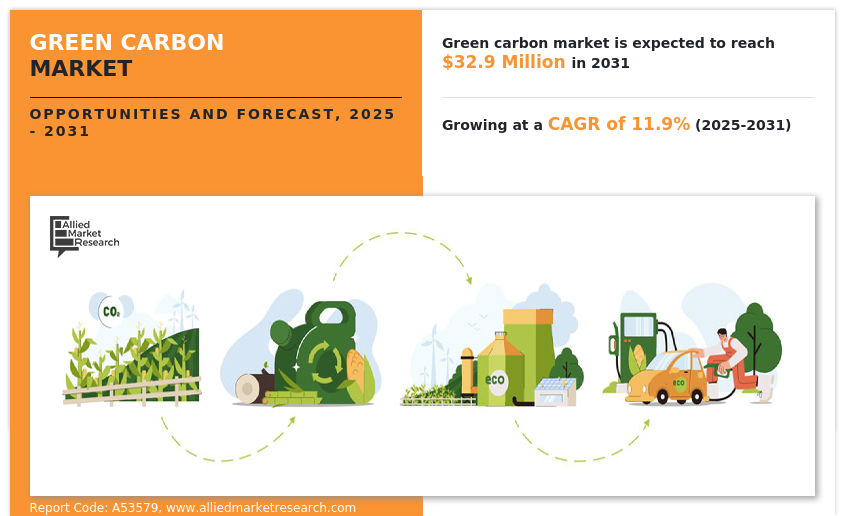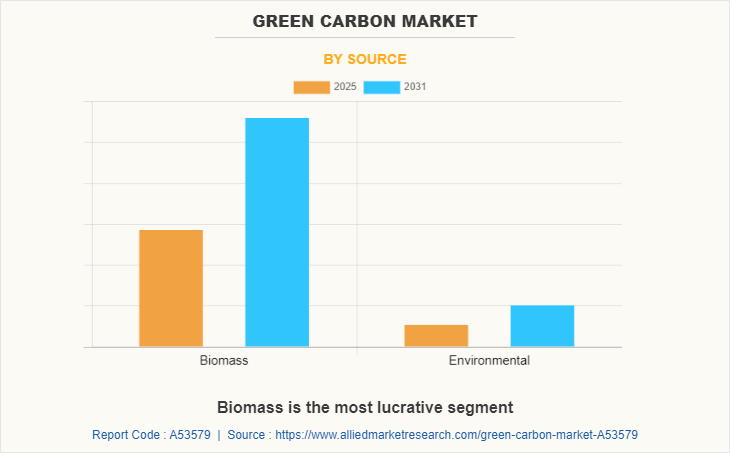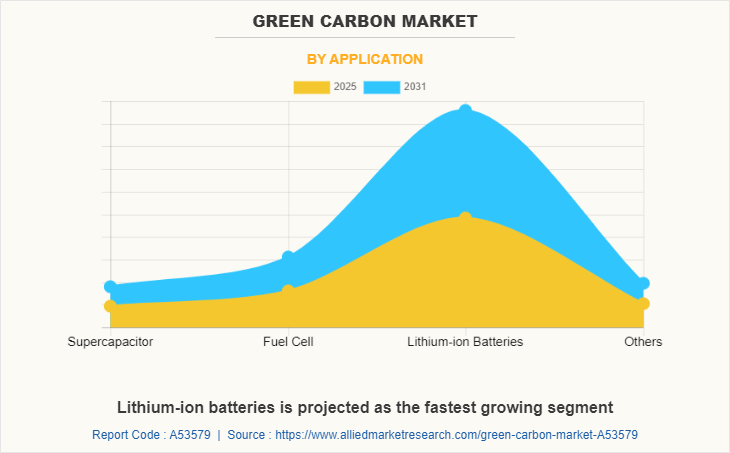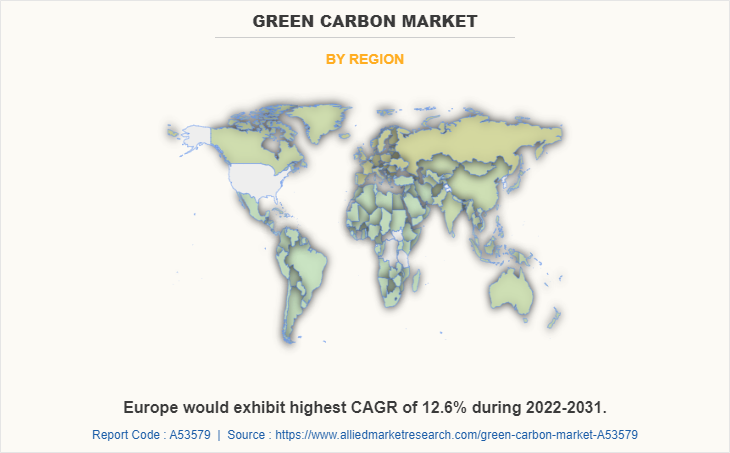Green Carbon Market Outlook - 2031
The global green carbon market size is expected to value for $16.8 million in 2025, and is projected to reach $32.9 million by 2031, growing at a CAGR of 11.9% from 2025 to 2031.
Green carbon is termed as the carbon that is stored in the biosphere, taken up from the atmosphere by plants through the process of photosynthesis. Green carbon ecosystems, such as those in natural forests, play a key role in impacting the levels of greenhouse gas concentrations in the atmosphere. Moreover, green/bio-based carbon can be produced from biomass through pyrolysis and hydrothermal carbonization.
Report Key Highlighters
- Latest trends in global green carbon market such as pilot phase development, green carbon commercial production, undergoing R&D activities, and government initiatives are analyzed across 19 countries in 4 different regions.
- The green carbon industry is consolidated in nature among companies such as include Mitsui Chemicals, Inc., TEIJIN LIMITED, Charm Industrial, Drax, and Clean Energy Systems. Moreover, it also provides other key raw material suppliers such as Vatenfall AB, Orsted A/S, Alstorm, Enviva, Clean Energy Systems, Babcock And Wilcox Enterprises, Inc.
- The study contains qualitative information such as the market dynamics (drivers, restraints, challenges, and opportunities), and Porter’s Five Force Analysis across North America, Europe, Asia-Pacific, LAMEA regions.

Current Scenario:
Currently, the green carbon is under pilot phase and is expected to commercialize in the global market by 2025. Several key companies such as Mitsui Chemicals, Inc., TEIJIN LIMITED, Charm Industrial, Drax, Clean Energy Systems, and others are constantly engaged in R&D activities to produce highly efficient green carbon at reduced prices. These companies are working on synthesizing of carbon nanoparticles (CNPs)-derived from renewable sources such as biomass, and others. This green synthesized CNPs, especially carbon nanotubes (CNTs), carbon quantum dots (CQDs) and graphene can be used for high-density energy storage media, environmental remediation materials and in biomedical applications.
Moreover, countries such as Brazil, the U.S., China, India, and others are constantly engaged in promoting green energy through rapid transition from the sectors that are dependence on fossil-based systems for energy production and consumption such as oil, natural gas, and coal to renewable energy sources like solar, wind, and others. This factor is creating investment opportunities for the commercial production of biomass-sourced green carbon. Furthermore, government agencies such as European Union (EU), the United States Environmental Protection Agency (US EPA), and others are promoting the development of green carbon. For instance, European Union has launched a program in 2020 named as Green Carbon 2020 to promote the utilization of green carbon for sustainable economy and to attract investments in the field. This factor has fueled R&D activities in the green carbon sector.
Market Dynamics:
Surge in population base coupled with rise in demand for consumer goods have led to rapid urbanization and industrialization in both developed and developing economies such as the U.S., China, India, and others. The rise in release of toxic chemicals and gases from industries, transport vehicles, and others have surged the level of greenhouse gases. This factor has led governments of various countries to put more emphasis on cutting greenhouse gas emissions to as close to zero as possible, with any remaining emissions re-absorbed from the atmosphere.
For instance, the Paris agreement promises to reduce the greenhouse gases by 45% by 2030 and reach net zero emissions by 2050. Green carbon/bio-based carbon is derived from sustainable sources such as biomass, and others that has negative or minimal impact on the environment if released directly to the atmosphere. This factor may surge the utilization of green carbon for energy generation, storage, and other applications; thus, boosting the green carbon market growth.
Moreover, green carbon has the potential to reduce greenhouse emission by 30%-70%, as compared to conventional carbon (carbon emitted from industrial sector, vehicles, and others). Moreover, green carbon production is an efficient process and requires 20% less energy than conventional carbon. It does not harm earth or environment, as green/bio-based carbon do not have any toxicity. Moreover, its greenhouse gas emission is minimal during the time of degradation.
Bio-based carbon represents a 42% reduction in greenhouse gases footprints. Various carbon manufacturing companies such as Mitsui Chemicals, Inc., TEIJIN LIMITED, and others are exhibiting their interest toward the production and usage of bio-based carbon, across various applications owing to its advanced technical properties and eco-friendly functionalities. This factor is projected to augment the growth of the green carbon market during the forecast period.
However, the cost involved in the formulation of green carbon is high that results in expensive final product as compared to conventional carbon capturing. Furthermore, green carbon is relatively expensive as compared to conventional carbon. In addition, the production of green carbon requires skilled workforce. These factors are projected to restrain the growth of the green carbon market during the forecast period.
On the contrary, the high price of green carbon is a major factor restraining the industry growth. This issue can be resolved with the volatility in crude oil price, which results in a price rise in petrol. Moreover, this issue can be resolved with decrease in dependence on petroleum resources and advancement in R&D. The industry, with a healthy capital base and good infrastructure is projected to adopt forward integration strategy to create their own value chain.
Furthermore, huge R&D investment is required to transform the innovations done in the development of highly efficient green/bio-based carbon into commercialization and the research should continue to increase efficiency of the material, simplify their synthesis, and maximize the usage of potential bio-based carbon across several end-use sectors. The manufacturers will be able to produce more valuable and less expensive green carbon with this development. This factor is projected to create remunerative opportunities for the green carbon market in the coming future.
Segment Overview
The green carbon market is segmented on the basis of source, application, and region. On the basis of source, the market is categorized into biomass and environmental. On the basis of application, it is divided into supercapacitor, fuel cell, lithium-ion batteries, and others. Region-wise, the market is studied across North America, Europe, Asia-Pacific, and LAMEA.

Green Carbon Market By Source
In 2025, the biomass segment is expected to be the largest revenue generator, and is anticipated to grow at a CAGR of 11.9% during the forecast period. Increase in awareness for eco-friendly activities coupled with rapid transition toward sustainable energy sources has surged the popularity of biomass-derived carbon owing to its environment-friendly properties. This factor is anticipated to augment the growth of the biomass-derived carbon during the forecast period.

Green Carbon Market By Application
By application, the lithium-ion batteries application segment is expected to dominate the global market in 2025, and is anticipated to grow at a CAGR of 12.1% during forecast period. The increase in adoption of lithium-ion batteries in renewable energy sector coupled with rise in demand for plug-in electric vehicles has surged the demand for lithium-ion batteries where green/bio-based carbon is widely used for producing anode materials. This may act as one of the key drivers responsible for the growth of the green carbon market for lithium-ion batteries.

Green Carbon Market By Region
The Europe green carbon market size is projected to grow at the highest CAGR of 12.6% during the forecast period and accounted for 41.6% of green carbon market share in 2025. Germany is the most promising country-level market in the region with increased production of biomass. According to a report published by Germany Bioenergy in 2021, around 55% of renewable energy is obtained from biomass. This may ease the green carbon producers for raw material availability in the European region.
Also, the region has a strong presence of key regulatory bodies such as the European Union Regulatory Commission, European Chemicals Agency (ECHA), Environmental Protection Agency, and others that are constantly engaged in reducing global carbon footprints and promote the use of green/bio-based carbon in several end use sectors. This factor may surge the popularity of green carbon across various end use sectors; thus, boosting the market growth.
Competitive Analysis
The global green carbon market profiles leading players that include Mitsui Chemicals, Inc., TEIJIN LIMITED, Charm Industrial, Drax, and Clean Energy Systems. Moreover, it also provides other key raw material suppliers such as Vatenfall AB, Orsted A/S, Alstorm, Enviva, Clean Energy Systems, Babcock And Wilcox Enterprises, Inc. The global green carbon market report provides in-depth competitive analysis as well as profiles of these major players.
Key Benefits For Stakeholders
- This report provides a quantitative analysis of the market segments, current trends, estimations, and dynamics of the green carbon market analysis from 2025 to 2031 to identify the prevailing green carbon market opportunities.
- The market research is offered along with information related to key drivers, restraints, and opportunities.
- Porter's five forces analysis highlights the potency of buyers and suppliers to enable stakeholders make profit-oriented business decisions and strengthen their supplier-buyer network.
- In-depth analysis of the green carbon market segmentation assists to determine the prevailing market opportunities.
- Major countries in each region are mapped according to their revenue contribution to the global market.
- Market player positioning facilitates benchmarking and provides a clear understanding of the present position of the market players.
- The report includes the analysis of the regional as well as global green carbon market trends, key players, market segments, application areas, and market growth strategies.
Green Carbon Market Report Highlights
| Aspects | Details |
| Market Size By 2031 | USD 32.9 million |
| Growth Rate | CAGR of 11.9% |
| Forecast period | 2025 - 2031 |
| Report Pages | 296 |
| By Application |
|
| By Source |
|
| By Region |
|
| Key Market Players | Clean Energy Systems, Orsted A/S, Alstorm, TEIJIN LIMITED, Enviva, Charm Industrial, Mitsui Chemicals, Inc., Drax, Babcock & Wilcox Enterprises, Inc., Vatenfall AB |
Analyst Review
According to CXOs of leading companies, the global green carbon market is expected to exhibit high growth potential. Application of green/bio-based carbon includes water splitting devices, nanotubes, electrical switching, thermal pastes, and others. Consumer electronics and renewable energy sector that require thermodynamic efficiency close to 100% can be accomplished with the use of green carbon.
In addition, green carbon can be used as a fuel in high-temperature fuel cells based on solid oxide, alkaline or molten carbonate technology. Increase in demand for clean power generation with minimal or less emission has surged the popularity of fuel cells where green carbon is widely used as a fuel for electricity generation. Furthermore, factors such as flexibility in operation, ease of availability, and minimal or no volatile organic compounds (VOCs) levels enhance performance of green carbon in several end-use industries. CXOs further added that sustained economic growth and increase in utilization of sustainable chemicals in various end-use sectors have increased the popularity of green carbon.
Increase in attempts for net zero coalition, environment-friendly properties of green carbon, and renewable raw material sources are upcoming trends in the green carbon market.
The lithium-ion batteries was the leading application segment in the global green carbon market.
Europe is expected to be the largest regional market for green market during the forecast period.
The green carbon market is expected to value for $16.8 million in 2025 and is estimated to reach $32.9 million by 2031, exhibiting a CAGR of 11.9% from 2025 to 2031.
Several key companies such as Mitsui Chemicals, Inc., TEIJIN LIMITED, Charm Industrial, Drax, and Clean Energy Systems hold a prominent share in the global green carbon market.
Loading Table Of Content...


